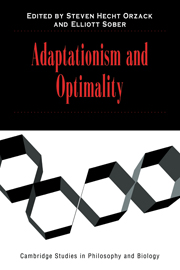Book contents
- Frontmatter
- Contents
- Contributors
- Acknowledgments
- Introduction
- 1 A Likelihood Framework for the Phylogenetic Analysis of Adaptation
- 2 Adaptation, Phylogenetic Inertia, and the Method of Controlled Comparisons
- 3 Optimality and Phylogeny: A Critique of Current Thought
- 4 Fit of Form and Function, Diversity of Life, and Procession of Life as an Evolutionary Game
- 5 Optimality and Evolutionary Stability under Short-Term and Long-Term Selection
- 6 Selective Regime and Fig Wasp Sex Ratios: Toward Sorting Rigor from Pseudo-Rigor in Tests of Adaptation
- 7 Is Optimality Over the Hill? The Fitness Landscapes of Idealized Organisms
- 8 Adaptation, Optimality, and the Meaning of Phenotypic Variation in Natural Populations
- 9 Adaptationism, Optimality Models, and Tests of Adaptive Scenarios
- 10 Adaptation and Development: On the Lack of Common Ground
- 11 Three Kinds of Adaptationism
- 12 Adaptation, Adaptationism, and Optimality
- Index
9 - Adaptationism, Optimality Models, and Tests of Adaptive Scenarios
Published online by Cambridge University Press: 06 January 2010
- Frontmatter
- Contents
- Contributors
- Acknowledgments
- Introduction
- 1 A Likelihood Framework for the Phylogenetic Analysis of Adaptation
- 2 Adaptation, Phylogenetic Inertia, and the Method of Controlled Comparisons
- 3 Optimality and Phylogeny: A Critique of Current Thought
- 4 Fit of Form and Function, Diversity of Life, and Procession of Life as an Evolutionary Game
- 5 Optimality and Evolutionary Stability under Short-Term and Long-Term Selection
- 6 Selective Regime and Fig Wasp Sex Ratios: Toward Sorting Rigor from Pseudo-Rigor in Tests of Adaptation
- 7 Is Optimality Over the Hill? The Fitness Landscapes of Idealized Organisms
- 8 Adaptation, Optimality, and the Meaning of Phenotypic Variation in Natural Populations
- 9 Adaptationism, Optimality Models, and Tests of Adaptive Scenarios
- 10 Adaptation and Development: On the Lack of Common Ground
- 11 Three Kinds of Adaptationism
- 12 Adaptation, Adaptationism, and Optimality
- Index
Summary
Consider the following three claims that could be made about the mean value of a particular trait in a biological population:
Natural selection is the most important evolutionary force acting on the trait, and there is abundant genetic variation for that trait in the population.
The trait value is adaptive, in the sense of resulting in higher fitness than many other potential values of that trait.
The trait value is optimal, in the sense that it results in fitness that is greater than or equal to the fitness of any other value of that trait within some specified range.
Each of these claims has played a major role in debates regarding the truth and usefulness of adaptationist and optimality approaches to understanding the current characteristics of living organisms, and they underlie much of the discussion that follows. Most evolutionary biologists are interested in understanding the evolutionary forces that produce the traits observed in present-day organisms and in the fossil record. The three preceding propositions are important because they bear on the validity of approaches that have commonly been used to try to discover these underlying evolutionary forces.
This chapter is divided into two sections. In the first section, I address the common belief that the predominance of natural selection combined with the continued presence of abundant genetic variation will imply adaptation or optimality (i.e., proposition 1 will imply 2 and/or 3). I argue that, in many situations involving frequency-dependent fitnesses and/or environmental variability, neither implication is justified.
- Type
- Chapter
- Information
- Adaptationism and Optimality , pp. 273 - 302Publisher: Cambridge University PressPrint publication year: 2001
- 8
- Cited by

